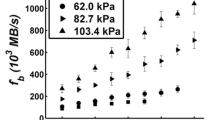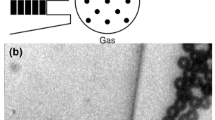Abstract
Limitations of existing thrombolytic therapies for acute ischemic stroke have motivated the development of catheter-based approaches that utilize no or low doses of thrombolytic drugs combined with a mechanical action to either dissolve or extract the thrombus. Sonothrombolysis accelerates thrombus dissolution via the application of ultrasound combined with microbubble contrast agents and low doses of thrombolytics to mechanically disrupt the fibrin mesh. In this work, we studied the efficacy of catheter-directed sonothrombolysis in a rat model of ischemic stroke. Microbubbles of 10–20 µm diameter with a nitrogen gas core and a non-crosslinked albumin shell were produced by a flow-focusing microfluidic device in real time. The microbubbles were dispensed from a catheter located in the internal carotid artery for direct delivery to the thrombus-occluded middle cerebral artery, while ultrasound was administered through the skull and recombinant tissue plasminogen activator (rtPA) was infused via a tail vein catheter. The results of this study demonstrate that flow focusing microfluidic devices can be miniaturized to dimensions compatible with human catheterization and that large-diameter microbubbles comprised of high solubility gases can be safely administered intraarterially to deliver a sonothrombolytic therapy. Further, sonothrombolysis using intraarterial delivery of large microbubbles reduced cerebral infarct volumes by approximately 50% vs. no therapy, significantly improved functional neurological outcomes at 24 h, and permitted rtPA dose reduction of 3.3 (95% CI 1.8–3.8) fold when compared to therapy with intravenous rtPA alone.





Similar content being viewed by others
References
Alexandrov, A. V., et al. Ultrasound-enhanced systemic thrombolysis for acute ischemic stroke. N Engl J Med 351:2170–2178, 2004.
Alexandrov, A. V., et al. A pilot randomized clinical safety study of sonothrombolysis augmentation with ultrasound-activated perflutren-lipid microspheres for acute ischemic stroke. Stroke 39:1464–1469, 2008.
Bekkers, S. C., S. K. Yazdani, R. Virmani, and J. Waltenberger. Microvascular obstruction: underlying pathophysiology and clinical diagnosis. J Am Coll Cardiol 55:1649–1660, 2010.
Berkhemer, O. A., et al. A Randomized Trial of Intraarterial Treatment for Acute Ischemic Stroke. N Engl J Med 372:11–20, 2015.
Bhatia, R., et al. Low rates of acute recanalization with intravenous recombinant tissue plasminogen activator in ischemic stroke: real-world experience and a call for action. Stroke 41:2254–2258, 2010.
Borrelli, M. J., et al. Influences of microbubble diameter and ultrasonic parameters on in vitro sonothrombolysis efficacy. J Vasc Intervent Radiol 23:1677–1684, 2012.
Broderick, J. P., et al. Endovascular therapy after intravenous t-PA versus t-PA alone for stroke. N Engl J Med 368:893–903, 2013.
Brujan, E. A., T. Ikeda, and Y. Matsumoto. Jet formation and shock wave emission during collapse of ultrasound-induced cavitation bubbles and their role in the therapeutic applications of high-intensity focused ultrasound. Phys Med Biol 50:4797–4809, 2005.
Brujan, E. A., and Y. Matsumoto. Collapse of micrometer-sized cavitation bubbles near a rigid boundary. Microfluid Nanofluid 13:957–966, 2012.
Campbell, B. C. V., et al. Endovascular therapy for ischemic stroke with perfusion-imaging selection. N Engl J Med 372:1009–1018, 2015.
Chen, J. L., A. H. Dhanaliwala, A. J. Dixon, A. L. Klibanov, and J. A. Hossack. Synthesis and characterization of transiently stable albumin-coated microbubbles via a flow-focusing microfluidic device. Ultrasound Med Biol 40:400–409, 2014.
Choi, J. J., et al. Microbubble-size dependence of focused ultrasound-induced blood-brain barrier opening in mice in vivo. IEEE Trans Bio-med Eng 57:145–154, 2010.
Crumrine, R. C., et al. Intra-arterial administration of recombinant tissue-type plasminogen activator (rt-PA) causes more intracranial bleeding than does intravenous rt-PA in a transient rat middle cerebral artery occlusion model. Exp Transl Stroke Med 3:10, 2011.
Daffertshofer, M., et al. Efficacy of sonothrombolysis in a rat model of embolic ischemic stroke. Neurosci Lett 361:115–119, 2004.
Dayton, P., J. Allen, and K. Ferrara. The magnitude of radiation force on ultrasound contrast agents. J Acoust Soc Am 112:2183–2192, 2002.
Dhanaliwala, A. H., et al. In vivo imaging of microfluidic-produced microbubbles. Biomed Microdev 17:23, 2015.
Dinia, M. R., M. Ribo, E. Santamarina, O. Maisterra, R. Delgado-Mederos, and J. Alvarez-Sabin, J. M., C. Molina,. Timing of microbubble-enhanced sonothrombolysis strongly predicts intracranial haemorrhage in acute ischaemic stroke. European Stroke Conference, 2008.
Dixon, A. J., and Hossack, J. A. Method and apparatus for accelerated disintegration of blood clot. United States of America Patent US9895158, 2018.
Dixon, A. J., A. H. Dhanaliwala, J. L. Chen, and J. A. Hossack. Enhanced intracellular delivery of a model drug using microbubbles produced by a microfluidic device. Ultrasound Med Biol 39:1267–1276, 2013.
Dixon, A. J., J. M. R. Rickel, B. D. Shin, A. L. Klibanov, and J. A. Hossack. In vitro sonothrombolysis enhancement by transiently stable microbubbles produced by a flow-focusing microfluidic device. Ann Biomed Eng 46:222–232, 2018.
Dixon, A. J., et al. Microbubble-mediated intravascular ultrasound imaging and drug delivery. IEEE Trans Ultrason Ferroelectr Freq Control 62:1674–1685, 2015.
Fan, Z., H. Liu, M. Mayer, and C. X. Deng. Spatiotemporally controlled single cell sonoporation. Proc Natl Acad Sci USA 109:1–4, 2012.
Gao, S., et al. Improvements in cerebral blood flow and recanalization rates with transcranial diagnostic ultrasound and intravenous microbubbles after acute cerebral emboli. Invest Radiol 49:593–600, 2014.
Garstecki, P., et al. Formation of monodisperse bubbles in a microfluidic flow-focusing device. Appl Phys Lett 85:2649–2651, 2004.
Goyal, M., et al. Randomized assessment of rapid endovascular treatment of ischemic stroke. N Engl J Med 372:1019–1030, 2015.
Helfield, B., X. Chen, S. C. Watkins, and F. S. Villanueva. Biophysical insight into mechanisms of sonoporation. Proc Natl Acad Sci USA 113:9983–9988, 2016.
Helps, S. C., M. Meyer-Witting, P. L. Reilly, and D. F. Gorman. Increasing doses of intracarotid air and cerebral blood flow in rabbits. Stroke 21:1340–1345, 1990.
Hettiarachchi, K., E. Talu, M. L. Longo, P. A. Dayton, and A. P. Lee. On-chip generation of microbubbles as a practical technology for manufacturing contrast agents for ultrasonic imaging. Lab Chip 7:463, 2007.
Jayaraman, M. V., J. A. Grossberg, K. M. Meisel, A. Shaikhouni, and B. Silver. The clinical and radiographic importance of distinguishing partial from near-complete reperfusion following intra-arterial stroke therapy. Am J Neuroradiol 34:135–139, 2013.
Jovin, T. G., et al. Thrombectomy within 8 hours after symptom onset in ischemic stroke. N Engl J Med 372:2296–2306, 2015.
Kilroy, J. P., et al. Reducing neointima formation in a swine model with IVUS and sirolimus microbubbles. Ann Biomed Eng 43:2642–2651, 2015.
Kim, J., et al. Intravascular forward-looking ultrasound transducers for microbubble-mediated sonothrombolysis. Sci Rep 7:3454, 2017.
Li, L., and Z. Zuo. Isoflurane preconditioning improves short-term and long-term neurological outcome after focal brain ischemia in adult rats. Neuroscience 164:497–506, 2009.
Longuet-Higgins, M. S. Viscous streaming from an oscillating spherical bubble. Proc R Soc Lond A 454:725–742, 1998.
Marler, J. Tissue plasminogen activator for acute ischemic stroke. N Engl J Med 333:1581–1588, 1995.
Marmottant, P., and S. Hilgenfeldt. Controlled vesicle deformation and lysis by single oscillating bubbles. Nature 423:153–156, 2003.
Marmottant, P., M. Versluis, N. de Jong, S. Hilgenfeldt, and D. Lohse. High-speed imaging of an ultrasound-driven bubble in contact with a wall: “Narcissus” effect and resolved acoustic streaming. Exp Fluids 41:147–153, 2006.
Mathias, Jr, W., et al. Diagnostic ultrasound impulses improve microvascular flow in patients with STEMI receiving intravenous microbubbles. J Am Coll Cardiol 67:2506–2515, 2016.
Molina, C. A., et al. Microbubble administration accelerates clot lysis during continuous 2-MHz ultrasound monitoring in stroke patients treated with intravenous tissue plasminogen activator. Stroke 37:425–429, 2006.
Molina, C. A., et al. Transcranial ultrasound in clinical sonothrombolysis (TUCSON) trial. Ann Neurol 66:28–38, 2009.
Porter, T. R., et al. The thrombolytic effect of diagnostic ultrasound-induced microbubble cavitation in acute carotid thromboembolism. Invest Radiol 52:477–481, 2017.
Postema, M., P. Marmottant, C. T. Lancee, S. Hilgenfeldt, and N. de Jong. Ultrasound-induced microbubble coalescence. Ultrasound Med Biol 30:1337–1344, 2004.
Powers, W. J., et al. 2015 AHA/ASA focused update of the 2013 guidelines for the early management of patients with acute ischemic stroke regarding endovascular treatment: a guideline for healthcare professionals from the American Heart Association/American Stroke Association. Stroke 46:3020–3035, 2015.
Rickel, J. M. R., A. J. Dixon, A. L. Klibanov, and J. A. Hossack. A flow focusing microfluidic device with an integrated Coulter particle counter for production, counting and size characterization of monodisperse microbubbles. Lab Chip 18:2653–2664, 2018.
Sakuma, T., H. Leong-Poi, N. G. Fisher, N. C. Goodman, and S. Kaul. Further insights into the no-reflow phenomenon after primary angioplasty in acute myocardial infarction: the role of microthromboemboli. J Am Soc Echocardiogr 16:15–21, 2003.
Saver, J. L., et al. Stent-retriever thrombectomy after Intravenous t-PA vs. t-PA alone in stroke. N Engl J Med 372:2285–2295, 2015.
Schleicher, N., et al. Sonothrombolysis with BR38 microbubbles improves microvascular patency in a rat model of stroke. PLoS ONE 11:e0152898, 2016.
Schwamm, L. H., et al. Temporal trends in patient characteristics and treatment with intravenous thrombolysis among acute ischemic stroke patients at get with the guidelines-stroke hospitals. Circ Cardiovasc Qual Outcomes 6:543–549, 2013.
Shortencarier, M. J., et al. A method for radiation-force localized drug delivery using gas-filled lipospheres. IEEE Trans Ultrason Ferroelectr Freq Control 51:822–831, 2004.
Talu, E., et al. Maintaining monodispersity in a microbubble population formed by flow-focusing. Langmuir 24:1745–1749, 2008.
Tissue plasminogen activator for acute ischemic stroke. The National Institute of Neurological Disorders and Stroke rt-PA Stroke Study Group. N Engl J Med 333:1581–1587, 1995.
Tomsick, T. TIMI, TIBI, TICI: I Came, I saw, I got confused. AJNR Am J Neuroradiol 28:382–384, 2007.
van Wamel, A., et al. Vibrating microbubbles poking individual cells: drug transfer into cells via sonoporation. J Control Release 112:149–155, 2006.
Wu, J. Theoretical study on shear stress generated by microstreaming surrounding contrast agents attached to living cells. Ultrasound Med Biol 28:125–129, 2002.
Wu, J. H., and S. L. Diamond. Tissue plasminogen activator (tPA) inhibits plasmin degradation of fibrin. A mechanism that slows tPA-mediated fibrinolysis but does not require alpha 2-antiplasmin or leakage of intrinsic plasminogen. J Clin Invest 95:2483–2490, 1995.
Yueh-Hsun, C., C. Po-Wen, and L. Pai-Chi. Combining radiation force with cavitation for enhanced sonothrombolysis. IEEE Trans Ultrason Ferroelectr Freq Control 60:97–104, 2013.
Acknowledgments
Partial support for this research is provided by the National Institutes of Health under NIH Grants S10 RR025594 and R01 HL141752 to JAH and by a NSF GRFP fellowship to AJD. The content is solely the responsibility of the authors and does not necessarily represent the official views of the NIH or NSF.
Author Contributions
AJD, JAH, ZZ conceived of study. AJD wrote main manuscript text. AJD, JMRR, JL conducted experiments and analyzed data. JAH, ALK, and ZZ supervised the study and all authors reviewed the manuscript.
Conflict of Interest
Authors AJD and JAH are inventors listed on an issued patent (US Patent No. 9895,158) that relates to some aspects of the content of this study.18
Author information
Authors and Affiliations
Corresponding author
Additional information
Associate Editor Agata A. Exner oversaw the review of this article.
Publisher's Note
Springer Nature remains neutral with regard to jurisdictional claims in published maps and institutional affiliations.
Rights and permissions
About this article
Cite this article
Dixon, A.J., Li, J., Rickel, JM.R. et al. Efficacy of Sonothrombolysis Using Microbubbles Produced by a Catheter-Based Microfluidic Device in a Rat Model of Ischemic Stroke. Ann Biomed Eng 47, 1012–1022 (2019). https://doi.org/10.1007/s10439-019-02209-0
Received:
Accepted:
Published:
Issue Date:
DOI: https://doi.org/10.1007/s10439-019-02209-0




